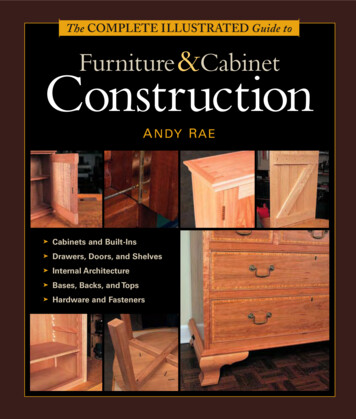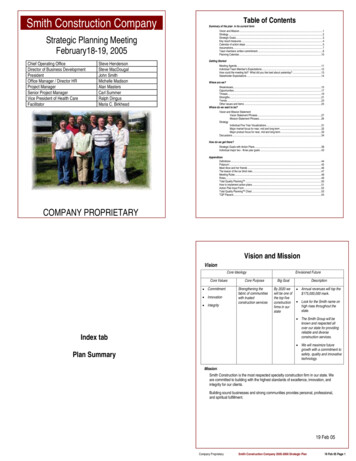
Transcription
The COMPLETE ILLUSTRATED Guide toFurniture &CabinetConstructionA N DY R A E Cabinets and Built-Ins Drawers, Doors, and Shelves Internal Architecture Bases, Backs, and Tops Hardware and Fasteners
The COMPLETE ILLUSTRATED Guide toFurniture &CabinetConstruction
The COMPLETE I LLUSTRATED Guide toFurniture &CabinetConstructionANDY RAEt
SECTION SEVEN OVERVIEWText 2001 by Andy RaePhotographs 2001 by Andy Rae (except where noted)Illustrations 2001 by The Taunton Press, Inc.All rights reserved.PpThe Taunton Press, Inc., 63 South Main Street, PO Box 5506, Newtown, CT 06470-5506e-mail: tp@taunton.comD ESIGN : Lori WendinL AYOUT: Steve Hughes, Suzie YannesP HOTOGRAPHER : Andy Rae (except where noted)I LLUSTRATOR : Melanie PowellLIBRARY OF CONGRESS CATALOGING-IN-PUBLICATION DATA:Rae, Andy.The complete illustrated guide to furniture & cabinet construction / Andy Rae.p. cm.Includes index.ISBN-13: 978-1-56158-402-4ISBN-10: 1-56158-402-91. Furniture making--Amateurs’ manuals. 2. Cabinetwork--Amateurs’ manuals. I. Title.TT195 .R34 2001684.1’04--dc212001033100Printed in Thailand15 14 13 12 11 10About Your Safety: Working with wood is inherently dangerous. Using hand or power toolsimproperly or ignoring safety practices can lead to permanent injury or even death. Don’ t try toperform operations you learn about here (or elsewhere) unless you’re certain they are safe foryou. If something about an operation doesn’ t feel right, don’t do it. Look for another way . Wewant you to enjoy the craft, so please keep safety foremost in your mind whenever you’re inthe shop.
To Paul McClure, head chief and happy woodworking hero who bridged allbarriers, social to scientific. May we reap the fruit of the wisdom he left behindon his beloved mother, the Earth.Acknowledgmentsirst, my humble appreciation to myeditors at The Taunton Press. I was luckyto have three: Helen Albert, associate publisher, whose eagle vision lifted an ideathat, at the outset, appeared too heavy to fly, andJennifer Renjilian and Tom Clark, for their support,steadfastness—and swift solutions.For excellent photographic services, I credit thefolks at Commercial Color in Allentown, Pennsylvania, and at Iris Photography in Asheville, NorthCarolina. And special thanks to John Hamel, photographer, for short- and long-distance mentoring, plussome pretty fine photos over the years.I’ve had the curious luck to know many fellowwoodworkers and writers on a personal level. Mydeepest gratitude goes to my woodworking and writing teachers, past and present, who have knowinglyand unknowingly inspired and taught: My creativemother, Johanna Weir, and my two artistic fathers, JudRae and Walter Weir, all three for their unique interest in making things; brother Gurnee Barrett, whodemonstrated it was worth doing right; GeorgeNakashima, for his unspoken commands, FrankKlausz, for his outspoken commands, and ToshioOdate, for speaking the unspoken; Dave Cann andPaul Connor, whose metalworking hands have savedmine many times; the crazy woodworking folks atArcosanti, including Kerry Gordon, Michael Christ,and Chris Fraznick; Fred Matlack, who never says itcan’t be done; Sue Taylor, for asking elucidative questions; Dave Sellers, for his anarchy with heart; JimCummins, for huge excitement in small things; RichWedler, whose woodworking is music to my ears;Jonathan Frank, for trusting woodworkers; PalmerSharpless, for his wisdom on woodworking—even inthe dark without electricity; “Old” Jim, Michael Burns,FJim Budlong, and David Welter, for teaching fromafar; William Draper, who gave me the freedom toexplore—and paid me for it; Tim Snyder, whoseinsights always point the way; Mira Nakashima, forbridging the old and the new; Lonnie Bird, who’squiet approach bespeaks fierce skill; Edward Schoen,for showing me how to problem solve my way out ofanything; Kitty Mace, for challenging everything; PatEdwards, for hosting itinerant woodworkers; NedBrown, who unwittingly inspired me to excel; SimonWatts, for being the gent of all gentleman woodworkers;Steve and Susan Blenk, for persistence and tall goodwill; Tom Brown, who patiently taught a young manthe art of installation; Leonard Lee, a bona-fide toolnut and enthusiast; Kevin Ireland, my first editor (younever forget your first); David Sloan, for curiouslyencouraging curiosity; Frank Pollaro, for adventureand bravado; Mike Dresdner, who’s always there whenthere’s nowhere else to go; Eric Stang, for enthusiasmand artistic inspiration; Paul Anthony, whose feedbackkeeps my feet on the ground; Janet Lasley, for helpingme to stay alive in the business of woodworking; Steve“Pimo” Metz and John Yarnall, who both demonstratethat patience and planning always win the day; EllisWalentine, for clever solutions and unexpecteddetours; Mike Callihan, for last-minute woodworking;the folks at the Lehigh Valley (Pennsylvania) Guild,for their sometimes embarrassing encouragement; RicHanisch, for having the courage to design from theheart; Peter Kauzman, for staying up late; and MannyPagan and Yeung Chan, both exemplifying what truewoodworking passion is all about.Last, I thank my family, Lee, Zy, and Shade—especially my wife, Lee Speed—for enduring my “oneyear leave of absence” for writing this book. I love youguys and always will.
ContentsIntroduction 2How to Use This BookPART ONE SECTION1 3Tools and Materials 6Shop Necessities 88 Shop Space and 11 Mobilize YourFixturesWorkshop SECTION2Woodworking Machines and Tools 1315 Basic Handheld 16 Favorite EdgePower ToolsTools17 FundamentalLayout Tools18 SharpeningGear20 Clamps
Working Wood 22SECTION 323 Buying and27 Flattening aPreparing SolidBoard by HandWood28 Smoothing30 Good Sandingwith Edge ToolsTechniques31 KeepingParts Flat33 Plywood andOther ManMade Boards36 Laying Outand CuttingPlywood38 Choosing andUsing Glue 35 MixingMaterialsSECTION 437 MakingYour MarkDesigning Furniture 4042 UnderstandingWood MovementPART T WO SECTION53 InsideCase Parts5Box and Case ConstructionBasic Cases 4657 Securingto a Wall 44
SECTION 664 Shelf Joinery 66 Open ShelvesSECTION 784 Nails andScrews SECTION92 ClampingProblemsShelves 5868 Shelf Options74 Dressing Upa ShelfNails, Screws, and Other Fasteners 8186 HardwareSolutions8Assembling Cases 88
SECTION 9Cutting and Attaching Moldings 9598 Working withMoldings SECTION 10110 DrawerConstruction Drawers 101115 TrayConstruction117 DrawerInteriorsS E C T I O N 1 1 Drawer Hardware 119124 Drawer Slides126 ComputerHardware127 Drawer Pulls
PART THREE SECTION136 Doors withPanels 12 SECTION165 Pulls andHandles130143 Glass LightsFitting and Hinging Doors 145153 SpecialtyHinges14 Building Doors 132141 Solid DoorsSECTION 13150 InstallingBasic HingesDoors157 ShopmadeHinges160 Hiding DoorsDoor Pulls and Hardware 161167 Locks171 Catches andBumpers
PART FOUR SECTION184 Toekicks SECTION15Bases, Feet, and StandsBases 178189 InstallingCabinets16Feet 19717Stands 206201 Feet andCasters SECTION208 Making Stands 176
PART FIVE SECTION220 Strong Joints xii225 LegsChairs and Stools 231241 Chair BacksSECTION 20250 Making FaceFramesLegs and Aprons 214223 Apronsand RailsS E C T I O N 19237 Chair Joints 18Frame Construction242 Chair SeatsFace Frames 247255 Corner UnitsGrooves, Dados and Rabbet Joints245 Hitting theFloor 212
SECTION261 MakingPanels21265 BackStrategiesPART SIX SECTION 22276 TopConstruction Frame and Panel 256Tabletops and Work SurfacesMaking Tops 270284 Top OptionsSECTION 23294 Allowing forMovementAttaching Tops 292297 HardwareSolutionsSources 300Further ReadingIndex 302288 Leavesand Ends 301 268
Introductionaking furniture is one ofthe most satisfying ways topass time: The schiiick of aplane iron on wood; thedizzying aroma of freshly sawn sugar pine orEast Indian rosewood; the endless array ofcolor, texture, and feel of woods from aroundthe world; the tense but joyful final assembly, when all work and toil come together ina conclusive burst of completion. Whatexcitement! This is the fine—and fun—artof woodworking. The reward is beautifulfurniture.To experience this excitement, you’ll needto have a degree of control over your workand your tools, command a working knowledge of your materials, and understand somebasic design principles. Unlike most othercrafts, furniture making and cabinetmakingdemand vast knowledge—and attentiveness.You must know what tools and techniquesto use and how to arrange the correctsequence, or order, of events when usingthem. You should listen with attentive earsand eyes to the material you’re working andchoose wood wisely, allowing for its eccentricities. With its countless pieces and parts,cabinetmaking involves a high level oforganization, and organizing your work andM2your shop space are part and parcel of thecraft. By combining all your skills, you canmake any type of furniture your dreams conjure up. You’re limited only by your imagination. I hope this book will provide you witha starting point for these skills. With practice, many small joys are waiting for you.They’re worth seeking.Above all, be patient. It takes time tomaster some of the smallest things. Thereare tricks and shortcuts, of course. Theycome with experience, and many are shownin the pages ahead. More important is theawareness that comes from trying manyapproaches and finding one that works foryou. In a very real sense, woodworking is apersonal journey. That’s because there is noright or wrong way of making furniture.What counts is what works. After 20 plusyears of practicing the craft, I still searchdaily for new ways of working. Once youdiscover something that works, call it yourown, and stand by it. You’ll have foundsomething that will make your woodworkingmore pleasurable. And your fine furniturewill reflect the results.
How to UseThis Bookirst of all, this book is meantto be used, not put on a shelfto gather dust. It’s meant to bepulled out and opened on yourbench when you need to do a new or unfamiliar technique. So the first way to usethis book is to make sure it’s near where youdo woodworking.In the pages that follow you’ll find a widevariety of methods that cover the importantprocesses of this area of woodworking. Justas in many other practical areas, in woodworking there are often many ways to get tothe same result. Why you choose one methodover another depends on several factors:FTime.Are you in a hurry or do you havethe leisure to enjoy the quiet that comeswith hand tools?Your tooling.Do you have the kind ofshop that’s the envy of every woodworker ora modest collection of the usual hand andpower tools?Your skill level.Do you prefer simplermethods because you’re starting out or areyou always looking to challenge yourself andexpand your skills?The project.Is the piece you’re makingutilitarian or an opportunity to show offyour best work?In this book, we’ve included a wide variety of techniques to fit these needs.To find your way around the book, youfirst need to ask yourself two questions:What result am I trying to achieve? Whattools do I want to use to accomplish it?In some cases, there are many ways andmany tools that will accomplish the sameresult. In others, there are only one or twosensible ways to do it. In all cases, however,we’ve taken a practical approach; so you maynot find your favorite exotic method fordoing a particular process. We have includedevery reasonable method and then a few justto flex your woodworking muscles.To organize the material, we’ve brokenthe subject down to two levels. “Parts” aremajor divisions of this class of techniques.“Sections” contain related techniques.Within sections, techniques and proceduresthat create a similar result are groupedtogether, usually organized from the mostcommon way to do it to methods requiringspecialized tools or a larger degree of skill.In some cases, the progression starts withthe method requiring the most basic technology and then moves on to alternativemethods using other common shop toolsand finally to specialized tools.3
SECTION SEVEN OVERVIEWThe first thing you’ll see in a part is agroup of photos keyed to a page number.Think of this as an illustrated table of contents. Here you’ll see a photo representingeach section in that part, along with thepage on which each section starts.Each section begins with a similar “visualmap,” with photos that represent majorgroupings of techniques or individual techniques. Under each grouping is a list of thestep-by-step essays that explain how to dothe methods, including the pages on whichthey can be found.Sections begin with an “overview,” or briefintroduction to the methods describedtherein. Here’s where you’ll find importantgeneral information on this group of techniques, including any safety issues. You’llalso read about specific tools needed for theoperations that follow and how to build jigsor fixtures needed for them.The step-by-step essays are the heart ofthis book. Here a group of photos representsthe key steps in the process. The accompanying text describes the process and guides youthrough it, referring you back to the photos.Depending on how you learn best, eitherread the text first or look at the photos anddrawings; but remember, they are meant towork together. In cases where there is anThe “VISUAL MAP” tells you whereto locate the essay that details theoperation you wish to do.The “OVERVIEW”gives you importantgeneral informationabout the group oftechniques, tells youhow to build jigsand fixtures, andprovides advice ontooling and safety.SECTION 12?OVERVIEWSECTION 12?OVERVIEWBuilding?Doorshe first decision you’re facedwith when making a door is todecide on its style. Choices aboundhere and include the use of solid wood,veneers, and moldings. The next step is toensure that the door you build will staytogether through years of use. There are fewitems in furniture making that get more abusethan the typical cabinet door, so the joineryyou select has to stand the test of time. Jointsm
The complete illustrated guide to furniture & cabinet construction / Andy Rae. p. cm. Includes index. ISBN-13: 978-1-56158-402-4 ISBN-10: 1-56158-402-9 1. Furniture making--Amateurs’ manuals. 2. Cabinetwork--Amateurs’ manuals. I. Title. TT195 .R34 2001 684.1’04--dc21 2001033100 Printed in Thailand 15 14 13 12 11 10 Pp










